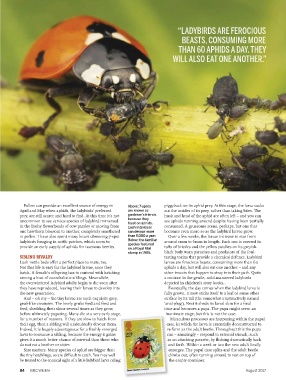Page 84 - BBC Wildlife - August 2017 UK
P. 84
“LADYBIRDSARE FEROCIOUS
BEASTS,CONSUMING MORE
THAN 60APHIDSADAY.THEY
WILL ALSO EAT ONE ANOTHER.”
Pollen can provide an excellent source of energy in Above: 7-spots piggyback on its aphid prey.Atthis stage, the larva sucks
April and May when aphids, the ladybirds’ preferred are known as out the insides of its prey, rather than taking bites. The
prey, are still scarce and hard to find. At this time it’s not gardener’s friends husk and head of the aphid are often left – and you can
because they
uncommon to see various species of ladybird immersed see aphids running arounddespite havingbeen partially
feast on aphids.
in the frothy flowerheads of cow parsley or moving from Each individual consumed. A gruesome scene, perhaps, but one that
one hawthorn blossom to another, completely smothered can devour more becomes even more so as the ladybird larvae grow.
in pollen. I have also spent many hours observing7-spot than 5,000 a year. Over a few weeks, the larvae increase in size from
Below: the familiar
ladybirds foraging in nettle patches, which seem to around 1mm to 6mm in length. Each one is covered in
species featured
provide an early supply of aphids for ravenous beetles. tufts of bristles and the yellow patches on its greyish-
ona RoyalMail
stamp in 1985. black body warn parasites and predators of the foul-
SIBLING RIVALRY tasting toxins that provide a chemical defence. Ladybird
Lush nettle beds offer a perfect place to mate, too. larvae are ferocious beasts, consuming more than 60
Not that life is easy for the ladybird larvae, once they aphidsa day, but will also eat one another–and any
hatch. A female’s offspring has to contend with hatching other insects that happen to stray into their path. Quite
among a host of cannibalistic siblings. Meanwhile, a contrast to the gentle, mild-manneredladybirds
the overwintered ladybird adults begin to die soon after depicted in children’s story books…
they have reproduced, leaving their larvae to develop into Eventually,theday comes when the ladybird larva is
the new generation. fullygrown. It now sticks itself to a leaf or some other
And –oh my–the tiny larvae are such exquisite grey, surface by its tail (the somewhat unattractively named
grub-like creatures. The lovely grubs feed and feed and ‘anal plug’). Next it sheds its larval skin for a final
feed, shedding their skins several times as they grow, time and becomes a pupa. The pupa might seem an
before ultimately pupating. Many die at a very early stage,, inanimate stage, but this is not the case.
for a number of reasons. If they are slow to hatch from Miraculous processes are happening within the pupal
their egg, thenasibling will undoubtedly devour them. ca ase, in which the larva is essentially deconstructed to
Indeed, it is hugely advantageous for a freshly emerged re e-form as the adult beetle. Throughout this the pupa
larva to consume a sibling, because the energy it gains c an – amazingly – respond to external stimuli, such
gives it a much better chance of survival than those who a as an attacking parasite, by flicking dramatically back
do not eat abrother or sister. a and forth. Within a week or two the new adult finally
Size matters. Many species of aphid are bigger than e emerges. The pupal case splits and the adult beetle
the tiny hatchlings, so are difficult to catch. You may well c climbs out, often turning around to rest on top of
be treated to the comical sight of a little ladybird larva ridingg t the empty container.
84 BBC Wildlife August 2017

